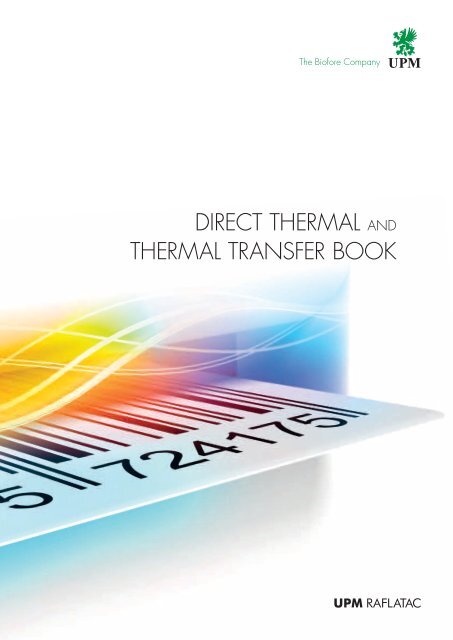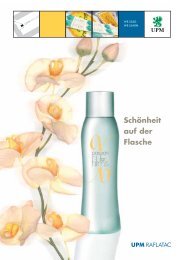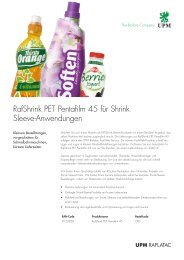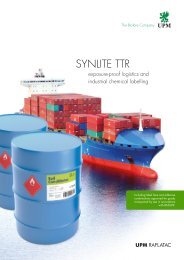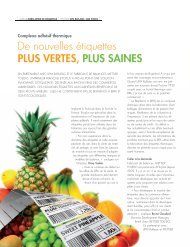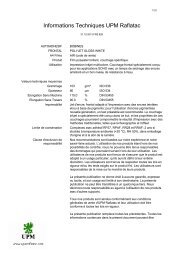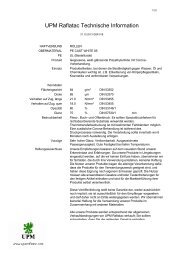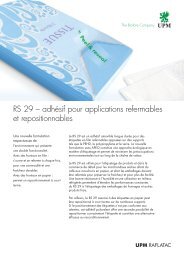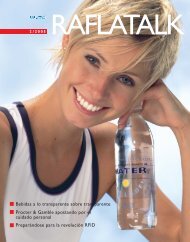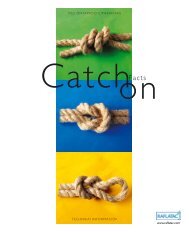Zadruk termiczny i druk termotransferowy - UPM Raflatac
Zadruk termiczny i druk termotransferowy - UPM Raflatac
Zadruk termiczny i druk termotransferowy - UPM Raflatac
You also want an ePaper? Increase the reach of your titles
YUMPU automatically turns print PDFs into web optimized ePapers that Google loves.
Direct Thermal andThermal Transfer Book
TTR TechnologyHow it worksThermal transfer printing creates an image bymelting solid ink coated on a filmic ribbonand transferring it onto a receiving material.The receiving material can be an uncoatedpaper, a coated paper or a film.Thoughalmost all pressure sensitive labelstockscan be printed by thermal transfer, the bestresults are achieved with the use of carefullyselected materials. Depending on the type ofprint and level of quality that converters andtheir customers require, a suitable ribbon mustbe used in combination with an appropriateand correctly set printing device.Printers and thermal print headsIndustrial thermal transfer printers, whichtypically have a resolution of 8 dots/mmand work at speeds below 305 mm/s, useflat thermal print heads. With flat-type printheads, it takes longer to transfer the inkthan with near- and corner-edge technology.With near- and corner-edge technology theink is transferred very quickly, as the ribbon isremoved while the ink is still molten. Industrialnear- and corner-edge printers typically workbelow 12 dots/mm and 254 mm/s.Label faces and ribbon compatibilityThe chemical and physical properties on the surface ofa labelstock’s face material determine the type of thermaltransfer ribbon that will be compatible. There are threemain types of ribbon.WAX ribbons are the most commonly used ribbon typeand provide an economical solution for thermal transfer.Designed for use with flat-type print heads, wax ribbonscan be used with comparatively absorbent uncoated facepapers as well as with coated papers.WAX/RESIN ribbons supply high performance for avariety of end-uses. The mechanical resistance of theprinted image is very good. Wax/resin ribbons areintended for use with non-absorbent materials such ascoated paper and films, but they can also be usedwith Vellum when exceptional mechanical resistanceis required. Wax/resin ribbons can be printed withnear-edge and corner-edge print heads.RESIN ribbons are designed for use in very demandingapplications. Images printed with a resin ribbon have veryhigh resistance to mechanical wear, solvents and heat.This type of ribbon is usually used with filmic face materialslike PE, PP and PET, and comparatively less transfer ink isrequired to produce an opaque image.Peel-off pointRibbonrewindPrintheadRibbonunwindFlat-typeprint headribboninkheaterSolid phaseMolten phaseRibbonsensorNear-edgeprint headLabel unwindPressure rollerSource: Sony Chemicals Corporation4
The thermal transferproduct rangeAll the following TTR products perform reliably and offer a consistentlyhigh-quality thermal transfer with selected ribbons.Vellum TTRSurface-sized, wood-free, supercalendered paper.A universal label paper for commercial andgeneral labelling requiring variable informationprinting by thermal transfer.Vellum TTR can be used with wax andwax/resin ribbons, depending on the requiredscratch/smudge resistance and heat tolerance.Vellum PREMIUMSurface-sized, wood-free, supercalendered paper.Targeted to businesses which require maximumproductivity through high converting speeds.Vellum Premium has enhanced thermal transferprintability compared to Vellum TTR due to improvedsurface properties.Vellum Premium can be used with wax andwax/resin ribbons, depending on the requiredscratch/smudge resistance and heat tolerance.Transfer MattMatt-white, off-machine coated, wood-free supercalenderedlabel paper.For multipurpose labels with a matt finish.Designed for thermal transfer printing with goodbar code resolution.Transfer Matt can be used with wax andwax/resin ribbons depending on the requiredscratch/smudge resistance and heat tolerance.High opacity and brightness levels.Transfer XtraWood-free label paper, matt-coated on one sidefor optimal thermal transfer printability.Specially designed for thermal transfer applicationsto give the highest character definition andbar code resolution. Also accepts the main typesof press print including water-based flexography.Raflabrite-FSCWhite, wood-free, machine-coated, supercalenderedmidgloss paper.A multipurpose label paper for high-qualitymulticolour labels requiring good print definitionand fine detail.Typical end-uses are food and product informationlabelling where gloss is required. Raflabrite-FSC can be printed with wax/resin ribbons.FilmsSyntransferSyntransfer is a matt-coated, white highly opaque polyethylene filmdesigned for thermal transfer applications. It offers excellent printand overprint properties coupled with stiffness suitable for automaticdispensing.The strength of Syntransfer’s coating makes it ideal for outdoorapplications where high-strength properties and resistance tosmudging are a must.Syntransfer is printable with wax,wax/resin and resin ribbons.Polyprint 100Polyprint 100 is synonymous with chemical drum labelling. It is ahigh-density polyethylene film with a matt-white coating.This label material is durable, almost completely tear-proof, andresistant to water and most oils and chemicals.Its chemical compositionalso provides good stability under exposure to sunlight outdoors.Polyprint 100 gives a smudgeproof print using wax, wax/resin andresin ribbons, and also prints well with the main printing processes.Synlite TTRSynlite TTR is a white, opaque, matt coated PP-based film.Its thinner nature makes it ideal for hand applied labels andautomatic dispensing of large labels in logistics and industrialchemical enduse areas. It offers good chemical and environmentalresistance and smudgeproof performance using selected TTRribbons. Synlite TTR is printable with wax, wax/resin and resinribbons.SynLite TTR, Syntransfer and Polyprint 100 are all BS5609approved with selected adhesives.Other TTR film productsTop-coated BOPP, PE and PET products are also suitable for usein a range of applications involving information labels overprintedby thermal transfer. Please refer to our technical information sheetsfor details of our filmic face materials and their suitability. <strong>UPM</strong><strong>Raflatac</strong> also provides a ribbon recommendations tool online tomatch appropriate combinations of face material and ribbon.5
Anintroductionto directthermalBecause labels printed by direct thermal have a comparativelyshort lifespan due to the way the imagetends to fade over time, the main end-use areas forlabels printed by direct thermal are service counterand self-service price labelling, backroom weightpricelabelling in retail, industrial shipping & logisticsapplications as well as automatic labelling in foodindustry.Direct thermal papers are classified into three maincategories, Eco, barrier-coated on one side and barrier-coatedon both sides. The thermal layer on Ecopapers is unprotected, and the stability of the printedimage against chemicals, water and abrasion islimited. The thermal layer on papers with a singlecoat is protected on the printed side of the label toprovide higher image stability and good scratchresistance. Thermal papers with a barrier coat onboth sides provide even greater image stability andresistance to water, plasticizers and oil, for example.The second coat also prevents substances migratingup through the reverse side of the label. Even so, itshould be remembered that printed thermal paperswith a barrier coat on both sides still have a limitedlifespan.7
DT TechnologyHow it worksDirect thermal products derive theirfunctionality from thermochromism,which describes the ability of a substanceto alter in colour due to achange in temperature.The thermal layer in all direct thermalproducts contains three main components:a colourless dye (colour former),an acidic material (colour developer)and a sensitizer. Various quantities ofpigments, binders and additives arealso included.ECO or barrier-coated?ECO• No topcoat• No resistance to plasticizers, oil or water• No scratch resistance• Recommended for short life in a safeenvironmentThermal coatBase paperHeatImageThermal headONE-SIDE COATED• Barrier-coated on topside• High bar-code scratch resistance• Good image stability• Recommended for logistic labelsBacking rollTop barrierThermal coatThermal paperBase paperA microencapsulated solid blend ofcolour former and sensitizer melts underthe thermal print head (e.g. at 250 C)and reacts with the colour developer.As a consequence of this chemical reaction,the pH decreases inside the microcapsule,the colour former is protonated,and it transforms into a coloured form.This reaction is reversible, so the printedimage can fade or totally disappear dueto exposure to water, light, oil, plasticizersand solvents.TWO-SIDES COATED• Barrier-coated on top and reverse side• Smudgeproof• Resists plasticizers, oil and water• Good scratch resistance• Well protected against chemical andmechanical stress and high humidityTop barrierThermal coatBase paperReverse-side barrier8
Thermal papersand sensitivityThe sensitivity of a direct thermal paper is a key influence onthe speed at which it can be printed and the quality of the image.There are two types of sensitivity: static and dynamic. In generalit can be said that an optimum thermal paper has low staticsensitivity coupled with high dynamic sensitivity.STATIC sensitivityStatic sensitivity indicates the temperature at which the thermalcoating starts to react, and this influences both the heat resistanceand the resolution of the printed image. Low static sensitivityprevents a premature reaction of the thermal layer duringlabel converting and makes it possible to use the printed labelsin a warm environment. Low static sensitivity also prevents anundesirable reaction in the thermal coating during the coolingstage of each printing pulse, ensuring a crisp image for troublefreescanning and reading.DYNAMIC sensitivityDynamic sensitivity defines the reaction speed of the thermalmaterial when printed. A high printing speed means that lessheat energy is supplied by the print head, in which case thethermal paper must have high dynamic sensitivity to generatea good optical image density. <strong>UPM</strong> <strong>Raflatac</strong> defines highspeedprinting as above 200 mm/s. Because dynamic sensitivityis the most important variable in direct thermal printing,dynamic sensitivity levels are included in our product names(200 = standard dynamic sensitivity, 300 = high dynamicsensitivity).1,61,61,41,41,21,21,01,00,80,8Optical density0,60,40,2060 70 80 90 100 110120 130 140 1500,60,40,201 2 3 4 5 6 7 8 9 10 11 12 13 14Temperature (°C)Head energy (mJ/mm 2 )Thermal top P 200 Thermal top 200 Thermal Eco 3009
The direct thermal product rangeECO PRODUCTSThermal Eco 300Non top coated paper with a highsensitivity thermal coating. Limited resistanceto thermal image scratching orsmudging.For information labelling in dry environmentssuch as price marking and othershort-life retail and logistics end-uses.Printing speed: up to 300 mm/s(plain label).Thermal Eco 200Non top coated paper with a standardsensitivity thermal coating. Limited resistanceto scratching or smudging of thethermal image.For short-life information labelling in dryenvironments such as weigh-price in foodretail. Avoid contact with moisture, oil,fats and plasticizers (PVC).Printing speed: up to 200 mm/s(plain label).Thermal Eco TP FREE-FSCNon top coated paper with a high sensitivitythermal coating. Produced withoutphenol-based chemistry. FSC-certified(mixed credit). Limited resistance to thermalimage scratching or smudging.For self-service scales, weigh-price,shipping and logistics labelling. Avoidcontact with moisture, oil, fats and plasticizers(PVC).Printing speed: up to 300 mm/s(plain label).Thermal Eco BPA FREE-FSCNon top coated paper with a highsensitivity thermal coating. Producedwithout BPA-based chemistry. FSC-certified(mixed credit). Limited resistance tothermal image scratching or smudging.For self-service scales, weigh-price,shipping and logistics labelling. Avoidcontact with moisture, oil, fats and plasticizers(PVC).Printing speed: up to 300 mm/s(plain label).FIT RANGE<strong>UPM</strong> <strong>Raflatac</strong> is constantlyco-operating with partners inwhole value-chain in order tobe able to launch improvedproducts. We aim to developnext generation products, which either bringmore value or higher productivity. Thanksto increased knowledge, new raw materialsand innovations we have been able tolaunch the FIT range, which combine higherproductivity and sustainability with no compromisein performance in its intended use.RETAIL ECO FIT PEFCNon-topcoated thermal paper with standardsensitivity. Limited resistance to thermal imagescratching or smudging. PEFC certified.For information labelling in dry environmentssuch as self-service scales in retail. Avoidcontactwith moisture, oil, fats and plasticizers (PVC).Printing speed: up to 200 mm/s (plainlabel).THERMAL ECO FIT PEFCNon-topcoated thermal paper with standardsensitivity. Limited resistance to thermal imagescratching or smudging. PEFC certified.For information labelling in dry end-use areassuch as retail and logistics. Avoid contactwith moisture, oil, fats and plasticizers (PVC).Printing speed: up to 200 mm/s (plainlabel).10
BARRIER-COATED PRODUCTSThermal Top 200Top side barrier coated paper witha standard sensitivity thermal coating.Thermal Top P 200Top and reverse side barrier coated paperwith a standard sensitivity thermal coating.Thermalite Top 200Top side barrier coated thin paper witha standard sensitivity thermal coating.Information labelling requiring good barcode scratch resistance to guaranteeexcellent scanning properties in dryend-use environments including retail,transport and logistics.For wide range of information and productlabelling requiring good environmentalresistance of the printed image in end-useareas such as food, retail, transport andlogistics.Information labelling requiring good barcode scratch resistance to guarantee excellentscanning properties in dry end-useenvironments including retail, transport andlogistics.Pre-printable with all press methodsincluding flexo (water, solvent and UV),letterpress and UV-offset.Pre-printable with all press methodsincluding flexo (water, solvent and UV),letterpress and UV-offset.Pre-printable with all press methods includingflexo (water, solvent and UV), letterpressand UV-offset.Printing speed:up to 200 mm/s (plain label).Thermal Top P 180Top and reverse side barrier coatedpaper with a standard sensitivity thermalcoating.For wide range of industrial applicationsincluding pre-packed foodstuffs labellingwhere premium resistance to oil andwater is required.Pre-printable with all press methodsincluding flexo (water, solvent and UV),letterpress and UV-offset.Printing speed:up to 180 mm/s (plain label).Printing speed:up to 200 mm/s (plain label).THERMAL TOP P 300-FSCTop and reverse side barrier coated paperwith a standard sensitivity thermal coating.For universal information and product labellingrequiring good environmental resistancefrom the printed image in end-useareas such as food, retail, transport andlogistics.Pre-printable with all press methods includingflexo (water, solvent and UV), letterpressand UV-offset.Printing speed:up to 300 mm/s (plain label).Printing speed:up to 200 mm/s (plain label).Thermal Durable P 300Top and reverse side barrier coated paperwith a high sensitivity thermal coating.For universal information and product labellingrequiring extremely good environmentaland heat resistance from the printed image.Typical applications include logistics,transport, retail and food labelling, wherethe label must remain readable for severalmonths.Pre-printable with all press methods includingflexo (water, solvent and UV), letterpressand offset.Printing speed:up to 300 mm/s (plain label).11
FILM PRODUCTSSynthermal P 200A top and reverse side barrier coatedPP film with a standard sensitivity thermalcoating.Printing speed: up to 200 mm/s(plain label).Synthermal CLEARTop-coated clear direct thermal film forinformation labelling where the label willnot obscure the contents of the labelledpackagePrinting speed: up to 200 mm/s(plain label).LUGGAGE TAG PRODUCTSLaminated with a 30-micron PPfilm, these products are designedespecially for Luggage Tag typeapplications where strong and tearresistant labels are required.Luggage Tag Eco 300Where image stability is not critical.Luggage Tag Top 200Where high image stability is required.Luggage Tag TopLite 200Where high image stability and a thinnerlaminate construction is preferred.These products are ideally suited forindoor use.For short-term outdoor use and otherapplications requiring high image stabilityand more a durable label, a filmicsolution is recommended.BOARD PRODUCTSThermal Eco BoardsNon top coated lightweight board witha standard sensitivity thermal coating.Limited resistance to thermal imagescratching or smudging.For information labelling, preferably inindoor applications such as retail, boardingcards and travel tags. Avoid contactwith plasticizers and fatty substances.Available in 100, 130, 150, 180 and220 g/m².Printing speed: up to 200 mm/s(plain label).Thermal Top BoardsTop and reverse side barrier coated lightweightboard with a standard sensitivitythermal coating.For information labelling in dry environments,e.g. hang and shelf tags, lotteryuse, ticketing, boarding passes, inventorycontrol tags.Available in 105, 150 and 170 g/m 2 .Printing speed: up to 200 mm/s(plain label).12
Direct thermal andpre-printed press inksPrinting a thermal paper with ink isno more complicated than printingon standard paper. However, someconsideration must be given to theink in order to avoid damaging thethermal printer or reducing the printquality. The use of a special rangeof inks is recommended for directthermal papers in order to avoidtrouble. Please contact your ink supplieror <strong>UPM</strong> <strong>Raflatac</strong> representativefor more information.Heat resistanceThe ink should be able totolerate the 250 °C generatedby the thermal print head. Inaddition to lowering the imagequality, molten ink residue onthe print head prevents propercooling and leads to burnout.Abrasive particlesTitanium dioxide is a very abrasivepigment. It is chiefly usedas a white colorant in waterbasedflexo inks. Creatinglighter colour shades by addinga white colorant is not recommendedas it has an adverseeffect on the service life of thethermal head.Ink adhesionon top-coated paperThermal Top papers are coated witha non-absorbent topcoat. In order toachieve optimal ink anchorage, specialinks must be used.Metallic coloursMetallic pigments are quite abrasive.The use of metallic inks on direct thermalpaper is not recommended as it reducesthe service life of the print head.Amine ratio and Thermal EcoIf the amine ratio in the ink is too high,the thermal layer in Thermal Eco willreact and turn grey, affecting the shadeof the pre-printed image. Check that theink is recommended for use with directthermal Eco papers.Storage and handlingrecommendationsRoom temperature+20°Cmax Relative humidity50%protect from lightno hot or damp conditions<strong>UPM</strong> <strong>Raflatac</strong> recommends that labelstockis stored in room temperature (+20 ºC)at a maximum relative humidity of 50%.Labelstock should be kept in its originalpackaging and protected from light.Damp or hot conditions should beavoided. The shelf life is calculated fromthe date of the labelstock’s manufactureand is based on the adhesive’s abilityto maintain optimal labelling propertiesduring storage.13
www.upmraflatac.com09/2013 ENG 1237 Copyright <strong>UPM</strong> <strong>Raflatac</strong>


